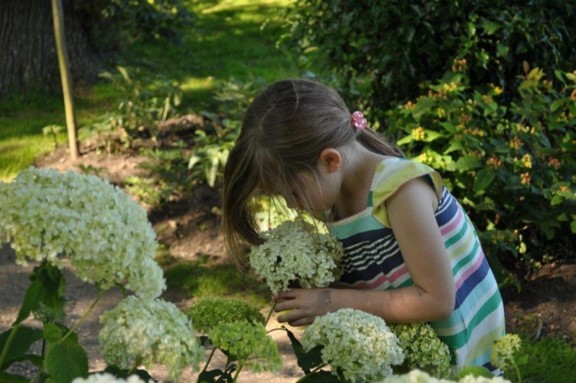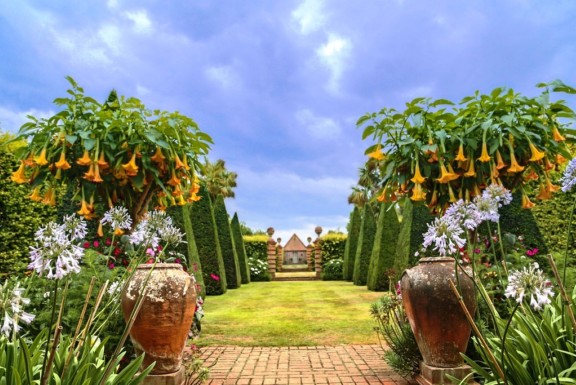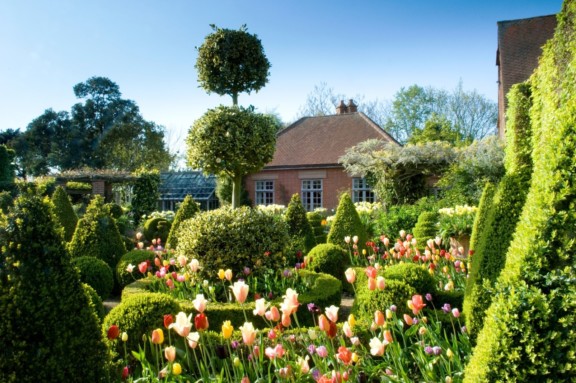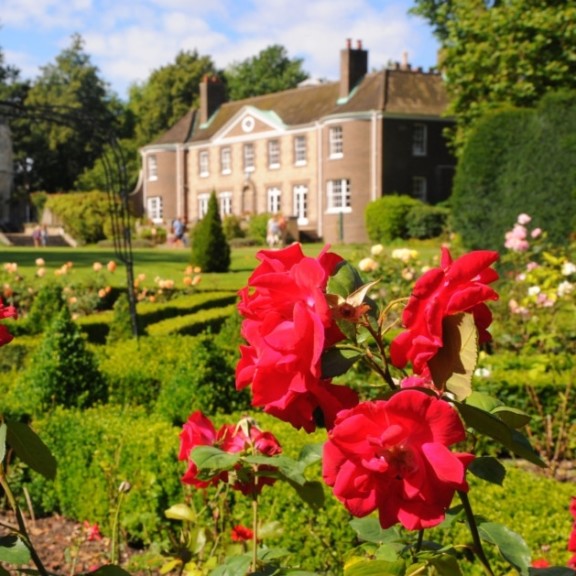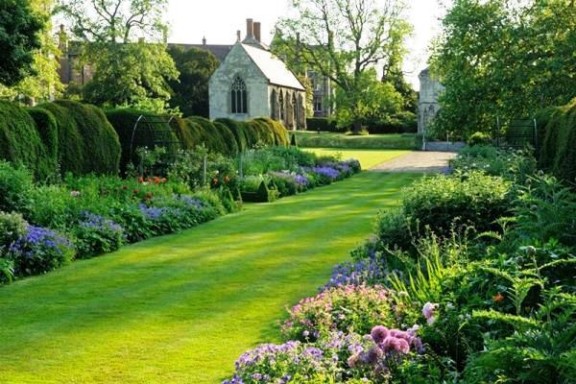Gems in the crown of Norfolk
Norfolk is a county of gardens and gardeners. Throughout the year there are constant posters and advertisements for snowdrop walks, bluebell woods, plant fairs, open gardens and events set within gardens, all of which entice and inspire us to think about our own gardens and what we could do in them next.
There is something for everyone, whether it be formal walled gardens with pristine beds and lawns, water gardens with exotic and bog-loving plants abound, wildlife areas and reservations (just right for children to explore and connect with nature) and the absolutely fantastic - gardens which show us just how far we can go with our imaginations and horticultural dreams.
Some of the gardens, I have included will be on many other lists for top places to visit, and some familiar names will crop up, but these really are the gems of gardens in the crown of Norfolk. If you regularly visit these places, why not go at a different time of year? Or if you think you've 'done' that garden and haven't been for a couple of years, why not go back this year? See what's been going on, there's bound to be something that's different as gardens are never static, they are in a state of constant flux, and if you think that you know that garden why not re-visit and be surprised...
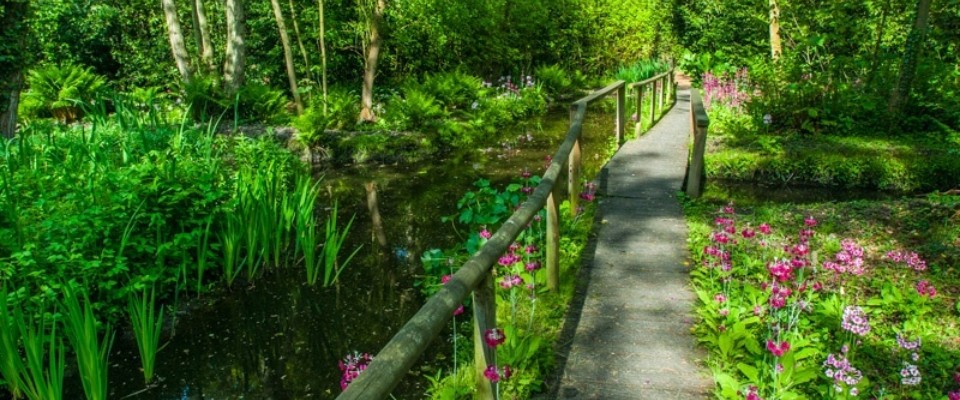
Fairhaven is the epitome of a stately Norfolk garden. It is not only on the edge of the Broads but it has its own inner Broad. The house and gardens have an interesting history, not the least in wartime where it had become a convalescence home and training ground for the home guard during World War Two. Tanks were hidden in the garden as well as sunken boats within the Broad to prevent flying boat landings.
In 1947 when the family moved to South Walsham hall, Major Henry Broughton, who later became the 2nd Lord Fairhaven, saw potential within this seemingly boggy jungle.
Being an enthusiastic gardener, he set about introducing waterways and bridges. He brought in plants which would thrive in the damp conditions specific to Fairhaven.
Now the garden is well-known for the glorious displays of Candelabra primula; 50,000 of which bloom in early May. Alongside these are the unusual Skunk Cabbage or Lysichiton americanus, distinctive for its 'skunky' odour and the glossy yellow flower (easily spotted being a member of the Arum family). They may not be the most attractive of flowers but a fascinating find for anyone interested in bog-loving plants. Look out for the ancient King and Queen oaks as well as a fishpond known as 'King Stephen's fishpond' which is actually listed in the Doomsday book.
Fairhaven sports many events throughout the year, from skavenger hunts for the kids, star watching nights as well as 'Primrose' the resident boat which visitors can take a trip on around the inner Broad. There is a cafe and plant shop which sells lots of the plants one can spot around the garden itself. Reasonably priced, this is a lovely day out for the family.
Fairhaven is open all year round, though the times vary depending on the time of year, boat trips are from April until October.
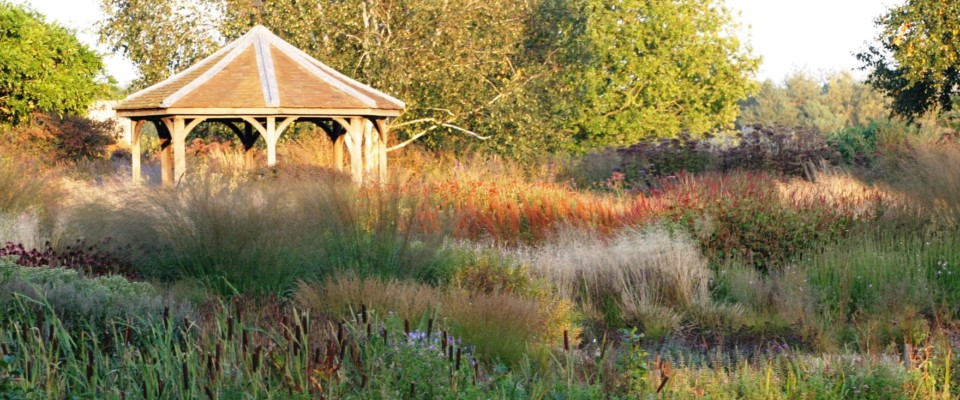
A whole article could be written about Pensthorpe Natural Park itself and if you haven't visited the spectacular reserve already, make sure you go without delay! Set within the 700 acre reserve are six exciting gardens in their own right, one of which I want to focus on now.
The Millennium garden was designed by renowned garden designer and plantsman Piet Oudolf. I have to confess this garden is listed here as his style is one of my absolute favourites and even if his is a bit too 'wild' for your taste, I think you will find his planting technique and ideas intriguing.
Hailing from the Netherlands, Oudolf considers the whole of a plant's life cycle when including it in his designs:
'A garden is exciting for me when it looks good through the year, not just at one particular time. I want to go outside and for it to be interesting in all weather, in early spring and late autumn.'
So he looks at the flowers, the foliage, and the seed heads when considering whether to include it in a garden. The Millennium garden displays this style to the full. There are swathes of bold colour in the Echinacea, Verbena and Persicaria, these are alongside drifts of neutral grasses which softens the outlines of the flowers. Oudolf plants in blocks of perennials so as to emphasise the colours, but this also provides essential habitats for butterflies and insects, as well as nesting materials in winter for birds. According to the website, the Millennium garden is at its peak in mid-August but the garden is worth a look at any time of year.
With its plethora of birds and wildlife to spot, as well as other gardens, lakes, a play park to end all play parks (WildRootz, best left to the end of your day as the kids won't want to leave!) a whole day is needed to really experience Pensthorpe. So if you have limited time in Norfolk, make sure it is one on your 'to do' list. Penshorpe is open all year round and has a gift shop and cafe.
There are many adjectives I could have used to try and describe this garden; 'artistic', 'innovative', 'exotic' and 'inspiring' to name but a few. This is also a well-known garden to those in the area, but in my opinion worth a visit at least twice a year as there's always something new to see.
Created by Alan Gray and Graham Robeson and established in 1973 the garden was built on the un-promising site a few miles from the coast and surrounded by arable farmland.
The Old Vicarage is surrounded by a wall thus protecting the plants and creating its own micro-climate which enables unusual and exotic plants to thrive, a shelter belt of striking Monterey pine and Italian alder was planted to add even more protection from the harsh coastal winds.
Here in North Norfolk you can find bananas, tree ferns, agaves, puyas and echiums all rubbing alongside the more traditional roses, stock or nepeta. As the website says 'we are always experimenting and pushing the boundaries.'
The Old Vicarage is a prime example of where limitless imagination, creativity and experimention can take you. The garden is divided up into specific habitats and designs such as the Desert Wash, the Dutch Garden (pictured above) or the Tea Garden.
Each area lovingly designed with meticulous care and thought; together with the astonishing landscaping, towering structures and inspiring sculptures there will always be surprises along the way. What I also love about the Old Vicarage is how the existing landscape has been incorporated into the garden itself. The owners use to their advantage their 'borrowed views' such as Happisburgh lighthouse which one can see, framed cleverly by a gap in the hedge.
The garden is open from March to October and private tours are available. Be sure to look in at the cafe for one of their (now renowned) cakes as well as a look at the collection of vintage tools on display. There is also a plant shop where you can buy plants propagated from the garden itself.
This garden isn't hidden in the fact that it's hard to spot, being in the shadow of Norwich Cathedral and its size makes it widely known, it's the fact that the garden is only open when hired for charity events that makes it limited to visit. But not to worry as the dates are advertised on its website so it's easy to organise a trip.
The four-acre garden has belonged to the Bishops of Norwich since 1100 AD. It is surrounded by high walls which are said to be over 700 years old but the general form of the garden as it is now, was laid down 300 years ago. There are many historic aspects to this garden, as you would expect for the age of it, including a large Tulip tree, one of the largest and oldest in Norfolk and a Hebe which was planted from a sprig taken from Queen Victoria's wedding bouquet in 1840.
As well as these points of interest there is the traditional wide herbaceous borders to enjoy, rose beds, an extraordinary hosta bed (where I challenge you to find larger and more beautiful examples anywhere) and an unusual grass labyrinth planted with wild flowers.
I was lucky enough to be taken around by the head gardener a couple of years ago, and it was his enthusiasm and creativity which has led to a number of rare and unusual species being included in the garden. Like the owners of the Old Vicarage, he is not afraid to experiment, quite a brave thing to do in such a historic and established site, but his boldness pays off as you will quite appreciate should you get there.
On charity days when the garden is open, there is usually teas and cakes available as well as a plant stall run by the employees of the garden itself.
The Traditional Walled Garden - Houghton Hall
I knew when I started to compile this list that it would have to include the classic example of a Great British Day Out which is a walk around a formal walled garden in the grounds of a stately home. Believe me it was a tough decision on which one to write about! Norfolk has many to choose from and you can see just how many on the National Garden Scheme website.
Although Houghton is well-known within the area and further afield, if you're unfamiliar with it - just go! As well as the hall, there is the acres of parkland with a large population of deer. Owned now by David and the 7th Marquess Cholmondeley, Houghton was landscaped in the 18th century by Charles Bridgeman, and it remains largely the same today (the original process involved the demolishing of the whole village of Houghton). It replaced the more formal geometry of intersecting avenues with blocks of woodland and parkland.
Today the estate includes contemporary works of art such as James Turrell's 'Sky Space' comprising of an oak clad structure in which visitors are invited to contemplate the sky through the frame of the open roof. There is also Richard Long's striking 'Full Moon Circle' (pictured below) and 'Houghton Cross', site specific pieces which won't fail to intrigue.
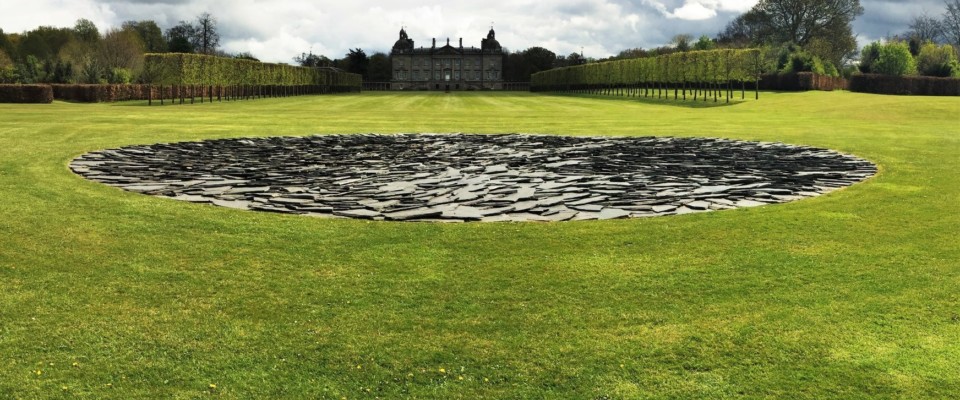
In the same way, I focused in on the Millennium garden at Pensthorpe (although there's acres more to explore) it's the walled garden at Houghton which is my main interest here. Spanning five acres, it was the winner of the Christie's and HHA 'Garden of the Year' in 2007. The walled garden is divided into different areas by Yew hedges, each of which is designed to provoke a specific interest or mood. There is an Italian enclosure with box parterres, a formal rose garden laid out to mirror one of the William Kent ceilings within the hall.
Another of the many highlights is 'Water Flame' by the artist Jeppe Heins, a 'contemporary folly' created especially for Houghton. It is comprised of a jet of water which is emitted from a ball of flame; fascinating to watch.
Back to the horticulture; one of my favourites is the Wisteria pergola, it's ethereal pendulous blossom are absolutely stunning in May or June. Together with the double herbaceous border, the Laburnam garden, a glass house, apple arches, fruit and vegetable beds, a cherry walk, magnolia corner and a rustic temple to name but a few, Houghton will continue to delight throughout your visit.
So there they are, the top five to think about visiting this coming spring and summer to get you in the mood for coming back to your own patch of garden, inspired and ready to burst into life, much like the plants! At present, with the snow lying in drifts all around, the green foliage and barrage of colour are hard to imagine and feel a long way off, but we must all keep ourselves warm with the thought that they won't be far away.
Article contributed by author and ‘The Village Gardener’ Fritha Waters.
Are you interested to read another top 5? How about our best picks for wildflower walks? Click here



